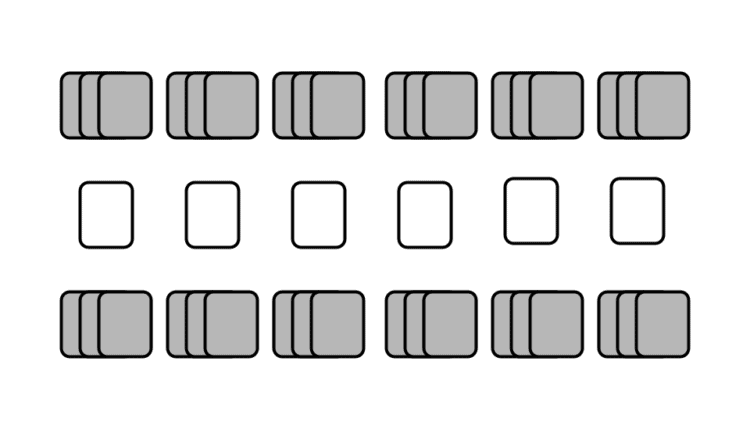
OBJECTIVE OF CHECKS: Be the player with the most points at the end of the game
NUMBER OF PLAYERS: 2 players
NUMBER OF CARDS: 52 cards
TYPE OF GAME: Fishing
AUDIENCE: Adults
INTRODUCTION OF CHECKS
Checks is a two player card capturing game created and published by James Yates. In this game, players are trying to claim target cards or target card piles by using the activated cards in their hands. Each card has a point value used to determine the value of the fan. While playing, players will have to decide whether to capture a target card, or strategically build up the target card piles in order to create larger point opportunities later in the game.
THE CARDS & THE DEAL
Checks uses a 52 card deck. Draw high card to see who deals first. Shuffle then deal six fans of three cards each face down to each player. Next, deal a row of six target cards face up. Players will be trying to win these cards. The rest of the cards are placed off to the side as a draw pile.

THE PLAY
Both players activate their first fan by picking it up. The first fan is the one furthest left for that player. Only the player holding the cards should see them. The non-dealer will go first.
WINNING TARGET CARDS
On a player’s turn, a player may claim a target card by using their activated fan.
Aces are worth 1, 2’s-9’s are worth the value of the card, and all face cards are worth zero. A fan cannot be worth more than ten points. Once a card is worth 11 or more, the value of the fan is based on the second digit only. So if a fan total adds up to 15, the fan’s value is only 5. A player claims a target card by matching the value of it to the value of their fan. When a player does this, they win the target card and all of the cards in their fan.
If the player is able to match their fan to any one target card, they do so by showing that their fan’s point total equals that of the target card. Then, that player collects the target card and places it and the fan together off to the side. That player immediately fills the gap in the target card row with the top card from the draw pile. When the draw pile is empty, play continues with the target cards remaining.
Example turn: Player 1 has a fan with a J, 7, and 3. That fan’s value is 10. There is a 10 target card. The player shows their opponent that their fan value equals 10 and captures the 10 target card. They place the J,7,3, and 10 in a pile off to the side.
UNABLE TO CLAIM A TARGET CARD
If a player is unable to claim a target card, they must choose one card from their fan and place it on top of any target card. The card they play becomes the new target card for that pile. After doing so, the fan’s value equals the total of the remaining cards.
A player does not have to claim a target card if they do not want to. They may choose to play a card to the target card row. This is up to the player. Either way, once the player has claimed a target card or played a card to the row, their turn is over.
When a player claims a target card that has grown into a pile, the player captures the entire pile with their fan. A target card pile is more valuable than a lone target card.
Once a player’s fan has been used or depleted, they may activate the next one by picking it up.
Play continues until both players have finished playing all of their cards. Once this occurs, it’s time to tally up the score. If playing more than one game, the winner deals the next one.
SCORING
Every card captured regardless of its rank is worth 1 point. At the end of the game, players count out all of the cards in their pile of captured cards. Any target cards remaining in play are not counted for either player.
WINNING
The player with the largest sum wins the game.
- TRIPLE SNAKES - February 15, 2021